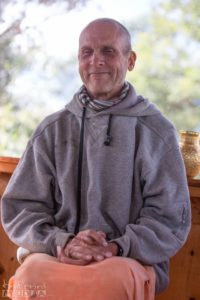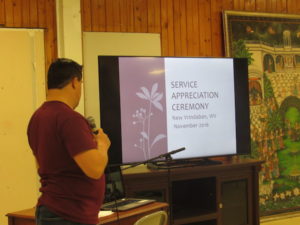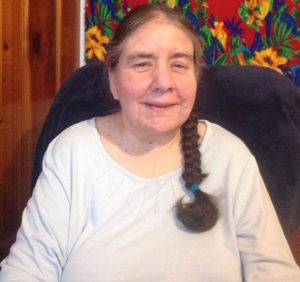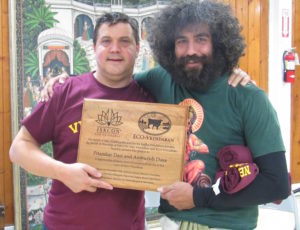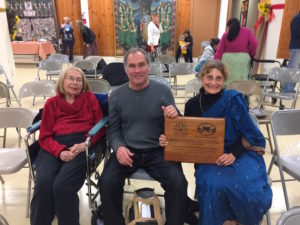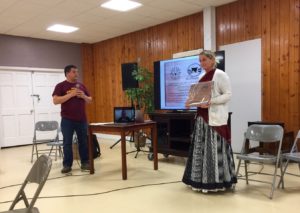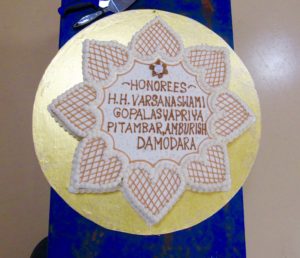Appreciation Ceremonies Honor Over 700 Years of Collective Service
By Madhava Smullen for ISKCON New Vrindaban Communications
New Vrindaban’s fifth Service Appreciation Ceremony, held on Sunday November 13th, began with some impressive statistics.
The semi-annual ceremony, launched in November 2014, has so far honored 22 individuals for their unique contributions to the development of New Vrindaban. And it has recognized over 700 years of collective service.
Started by ISKCON New Vrindaban and ECO-Vrindaban board members, the ceremony is inspired by Verse 4 of Rupa Goswami’s Nectar of Instruction. The six loving exchanges between devotees he describes, including giving and receiving gifts, revealing our minds and hearts, and sharing prasadam are all represented in some way at every ceremony.
In his purport, Srila Prabhupada writes, “The International Society for Krishna Consciousness has been established to facilitate these six kinds of loving exchanges between devotees,” and New Vrindaban members are taking this seriously, appreciating each other in heartfelt ways that are causing positive ripples throughout their community.
Around fifty gathered in the community hall under the Palace Lodge to honor five devotees, who also all received plaques from INV and ECO-V commemorating their lifetimes of service. MC Chaitanya Mangala began with Powerpoint presentations detailing each person’s life and contributions.
He started with Pitambar Dasi and her late husband Amburish Das, who passed away in 1989. Pitambar, who wasn’t able to physically attend due to health reasons, participated via Skype video, along with her two sons Acarya and Ananda. Her eldest son, Nitai, was present in the hall.
Amburish, the first devotee to be honored posthumously, moved to New Vrindaban in 1971 and was initiated by Srila Prabhupada that same year. An excellent kirtan leader and pujari, his favorite service during the 1970s and early ‘80s was caring for Krishna’s cows, which he did as if they were his own family.
Amburish was also renowned for his legendary sweet rice made with protected cow milk, which he cooked over a fire pit outside, and prepared with deep care and devotion.
Pitambar, who moved to New Vrindaban in 1976, met Amburish in the cow barn, where she took care of the calves just as diligently as he did the cows. She also churned butter by hand, prepared ghee and milk sweets for the Deities, and made gallons of ice cream with protected cow milk.
In the mid 1980s, she and Amburish oversaw the teenage boys’ ashram at the original Vrindaban farmhouse. Later, they worked at ISKCON’s restaurant in Pittsburgh, supplied the Rainbow Kitchen for the homeless with food; and throughout, raised their sons with love and dedication.
After Amburish’s passing, Pitambar started her own herbal goods cottage business to support herself and her boys, before moving to Pittsburgh in 2001, where she still lives.
Following the Powerpoint, New Vrindaban devotees poured their hearts out in appreciation of the couple, describing Pitambar as kind and loving, Amburish as hard working and enthusiastic, and both of them as role models for dedicated service.
In conclusion, eldest son Nitai stood and expressed gratitude for the appreciation of his parents. Hearing about his father, who had died when he was eight, was particularly uplifting. “Don’t give up on me yet, guys,” he chuckled. “I’ve still got time to try and fill those shoes.” Then, closing his eyes and raising his hands, he chanted the Hare Krishna mantra with such intensity and sincerity, in a voice so strikingly similar to Amburish’s, that not a dry eye was left in the house.
Another husband and wife couple, Damodar Das and Gopalasyapriya Dasi, were honored next. Gopa moved to New Vrindaban in 1975 from Detroit, and was initiated by Srila Prabhupada in November that year. Damodar came to New Vrindaban in 1978, after joining ISKCON in LA.
Both spent the late 1970s and the ‘80s on the road, fundraising for the community, before settling back in New Vrindaban in 1991. Damodara served as the temple president for several years, while Gopa ran the Krsna’s Attic thrift store and took care of the temple guest rooms. Around this time, she also began caring for the flower gardens around the temple and helping Prabhupada’s Palace Rose Garden caretaker Betty Hickey, whom she took over from in 2011.
Today, Damodar and Gopa still live in New Vrindaban, along with Gopa’s mother Anne, who also participated in the evening’s activities. Gopa continues to serve at the Palace Rose Garden, while Damodar volunteers for various restoration projects, such as the recent improvements on Prabhupada’s Palace, the temple guards Jaya and Vijaya, and the large Gaura Nitai sculptures.
Damodara also has another project. In the past, he recorded himself reading Srila Prabhupada’s Caitanya Caritamrita for his own use, but it was appreciated so much that he made it available to others. Now he’s collaborating with Tulasi Das to make audio recordings of all of Prabhupada’s books, which will be available on a new website in the next few months.
When appreciations were opened up to the floor, many ladies expressed their gratitude for Gopalasyapriya’s sweet and encouraging nature, and for the many times that she uplifted their spirits and kept them motivated when they were struggling.
Many devotees expressed similar sentiments about Damodar, saying his steadiness and determination inspired them to keep on with their service during challenging times.
Finally, everyone appreciated Varsana Swami, who respectfully declined to personally attend and instead encouraged his disciples to participate on his behalf. Those present included Sri Tulasi Manjari, Nitaicandra and Ananga Manjari.
One of New Vrindaban’s stalwarts, Varsana Swami has served there steadily for nearly forty-five years, moving to the community in 1972, and receiving initiation from Srila Prabhupada in 1973.
Working with draft animals in the 1970s before the introduction of tractors, he oversaw several teams of horses as they pulled equipment to cut hay, till garden beds and haul supplies to the different farms around New Vrindaban. He then became known for doing the majority of the landscaping at New Vrindaban, carving the holy dhama out of the existing contours of the West Virginia foothills.
Always seen driving heavy equipment, he and his team sculpted the beautiful shape of the land around Prabhupada’s Palace as we know it today; created Kusum Sarovara lake near the temple, leveled the temple grounds, and built the current road to the original Vrindaban farmhouse.
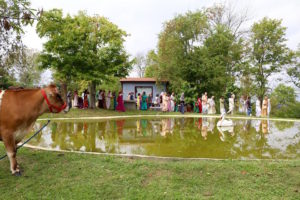
Varsana Maharaj escorts devotees on a parikrama around Radha Kunda during Radhastami 2016, following in the footsteps of the Six Goswamis.
More recently, he has “excavated” Radha Kunda and Lalita Kunda at Govardhana Hill in New Vrindaban, and is gradually constructing Radha-Gopinath Mandir, the first of Srila Prabhupada’s proposed replicas of the seven main temples of Vrindavan, India. This has become a much favored pilgrimage spot for the parikramas ISKCON New Vrindaban devotees regularly organize for guests.
Speaking about Varsana Swami, several longtime community members, including Pippalada, Gaura Shakti, Advaita, and others acknowledged that he and Amburish were two of the two hardest working members of New Vrindaban’s pioneer generation, out doing service right after mangala arati and not quitting until long after sundown.
They also appreciated his wonderful speaking abilities, recalling how in the early days, when he was known as Kashyapa Das, they were not yet evident. But as Varsana Swami studied Vaishnava scriptures intently over the years, and was cajoled into speaking by his peers, he grew to be the wise and eloquent teacher so many look to for inspiration today. He also authored two books, Gaura Lila and Path to Vraja.
After presenting Varsana Swami’s plaque to his disciple and ECO-V board member Sri Tulsi Manjari to give him later, the event concluded with a unique treat. In honor of Amburish and Pitambar, sweet rice was served out made by New Vrindaban’s pioneer dynamic cooking duo Advaita Das and Sudhanu Das, using Amburish’s classic recipe.
Having been shown by Amburish how he cooked sweet rice, they carefully recreated his methods by preparing it outside in a large pot over a fire pit, constantly stirring and aerating the sweet rice just as he did. They then kept the dessert in a freezer and fridge so it was served ice cold and with a distinct smokey flavor – two essential parts of the magic formula. The third, of course, was the love and devotion with which it was prepared.
“It was phenomenal,” says Chaitanya Mangala. “As Pitambar described Amburish’s sweet rice, it was truly heavenly.”
Ceremony participants savored the sweet rice along with a yellow cake with berry filling and whipped cream frosting, baked by Lakshman Ishvara Das and inscribed with the names of all the honorees. As they shared prasadam together, they kept the appreciative mood going in personal conversations.
“These events are definitely having an impact in the community, and I hope the mood of our appreciations will be expanded so they happen more often and in different ways,” says organizer and MC Chaitanya Mangala.
Others agree. “How can we go wrong when we glorify the devotees of the Lord?” asked Damodar Das. Meanwhile temple president Jaya Krsna Das commented that the appreciation ceremonies have become some of the most powerful community building activities he’s experienced during his time at New Vrindaban.
“It’s so important we let these devotees know their efforts are valued and appreciated, in order to help them maintain their enthusiasm and understand that their efforts are making a difference,” adds Chaitanya Mangala. “My hope is that we keep holding these ceremonies for as long as we have devotees to appreciate!”
